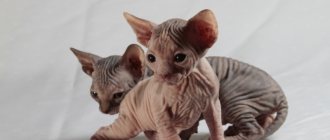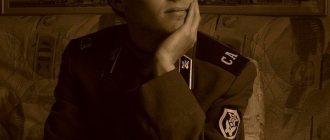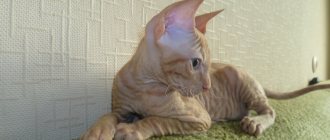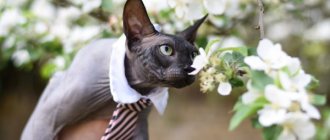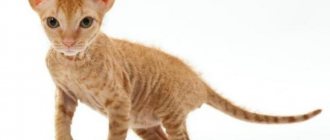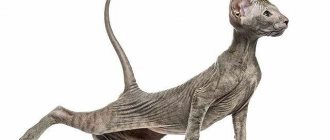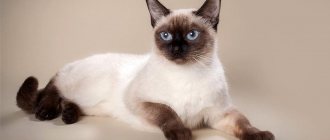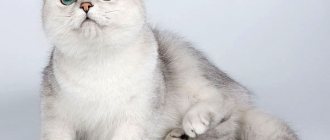Cats without hair are no longer considered a novelty, and it is no longer possible to surprise with them. Modern breeds of such cats make many people smile and want to touch their skin and stroke them. The Sphynx Brush is a cat with little fur on its body - the hair is short and sparse, more like fluff.
Don Sphynx brush.
Characteristics of the Don Sphynx - character and habits
The peculiar appearance of the Don breed sphinxes makes an indelible impression. Unusual hairless cats with large ears and folds all over their bodies are affectionate, not cat-like wise, and have a friendly disposition. With its expression of extreme concentration on its folded muzzle, the Donchak looks more like a pensive alien than a representative of the feline family.
Don cats are very social animals and love tactile contact. For good behavior, the Donchak expects a mandatory reward from the owner - a hairless cat always counts on stroking and other manifestations of affection. Due to their excessive affection, some animal lovers call the Don Sphynx a “kissing” breed.
Average lifespan
With proper care, the Don Sphynx lives 13–15 years. Obesity significantly reduces life expectancy, which causes diseases of the joints, heart, blood vessels, and digestive organs.
In order for your pet to remain healthy and live a long time, it is necessary to regularly take it to the veterinarian for preventative checks. At 6 weeks of age, the kitten is vaccinated against distemper, calcivirosis and rhinotracheitis.
At the 8th week of life, the pet is given a vaccine against rabies, at the 12th - against leukemia, at the 13th - against chlamydia. A one-year-old kitten is revaccinated, then the vaccinations are repeated annually. Before vaccination, the pet is given tablets to prevent helminthiasis.
Description of the breed
Russia is rightfully considered the birthplace of the Don cat. It was in the Russian Federation that they started breeding the Don Sphynx; the ancestor of the breed was a bald cat accidentally found by a compassionate woman. The small homeland of the Don cat is Rostov-on-Don.
Domestic hairless cats have a foreign twin brother - the Canadian Sphynx. But representatives of these outwardly similar breeds are not crossed with each other, due to the enormous differences in genetics.
Felinologists continue experiments with the domestic breed of hairless cats. This led to the appearance of exotic descendants of the Rostov (Kuban) sphinx - the St. Petersburg sphinx (Peterbald) was bred.
Today, the Don Sphynx as an independent breed is recognized by three felinological organizations: TICA (Donskoy, DSK), WCF (Don Sphynx, DSX) and FIFe (Don Sphynx, DSP).
Appearance - what the Don Sphynx looks like
Outwardly, the “Donetsk” looks more like an alien than a cat - representatives of this breed have bare, wrinkled skin, a thoughtful expression on the face, large almond-shaped eyes, the head is decorated with huge sensitive locator ears, and the Donets have extremely graceful and long paws and a tail. Domestic hairless cats have absolutely no hair.
At most, a light fluff 1-2 millimeters long may be present on the body of a Don cat. The fluff is soft; if you stroke the fluff on the body of a donkey, you will get the feeling of touching a peach.
The body of the Rostov Sphynx should be quite elongated, muscular and strong, with a noticeably protruding chest and a deep groin line.
The limbs of Don Chaks are long and slender, and the toes on their paws are much longer than those of representatives of other breeds. The toes on the paws are connected to each other by leathery membranes. The tail of the Rostov Sphynx is straight, long, thin, gradually tapering from base to tip.
The head of the Don Chaks is wedge-shaped, set on a low, thin neck. The muzzle features are sharp, the cheekbones are prominent, and the brow ridges are clearly defined. Donetsk people have a strong-willed, “courageous” chin.
The eyes are large, almond-shaped, the color of the iris depends on the main color. The breed standard allows heterochromia - when the color of the iris of one eye differs from the color of the other eye (scientific name - heterochromia).
The ears are large and slightly rounded. The forehead is flat, completely covered with small folds. The more folds a Don cat has on its body, the more highly valued it is. There are especially many wrinkles and folds in the fold areas.
Size and weight
Don Sphynxes are considered average in height among cats of other breeds - an adult cat grows up to 25-30 cm. The weight of an adult cat is 6-7 kg. The cats are smaller, so they weigh less - the average weight of a Don cat is 3.5-5 kg.
Sphinx weight by month (table)
Wool
This may seem strange to some, but hairless cats also have hair. However, the coat of the Donchak is completely different from the fur of an ordinary murka - rather, their delicate fluff resembles the fluff on the skin of a peach.
Often little Rostovites are born with fur; over time, some kittens go bald, but some of the babies will remain with a short velvet fluff on their body - velor (flock), or will be covered with short thin bristles - such Kuban Sphynxes are called brushes (brush).
Naked
Most of all, completely naked, hairless individuals are valued. Such Rostov sphinxes are also called “rubber” - small Donchaks are born without a single hair, completely bald. The more wrinkles a “rubber” cat has on its body, the more it is valued.
Flock
Kittens are not born bald - the babies' skin is covered with short, thin and soft hairs 1-2 mm long, which to the touch resemble the fuzz on the skin of a peach. As the animal grows, the flocked fur gradually rolls out and falls out.
Velours
Velor kittens are not born naked, but their delicate, velvety-to-the-touch hairs are longer than those of flocked kittens. The length of such velor hair can reach 2-3 mm. Over time, the velor cover falls out.
It is customary to distinguish three varieties of velor sphinxes:
- Lightweight velor . The length of the hairs is no more than 2mm.
- Velor point . The permissible length of pile on the paws and muzzle is up to 4 mm.
- Downy velor . Short, uniform coat over the entire body.
Brush
The body of Brush Don cats is covered with slightly curly, curly hair, which to the touch resembles short, stiff bristles. Usually, by the age of 2 years, a curly brush will go completely or partially bald.
Brash Donchaks are divided into three types:
- Velor brush , hair length - up to 0.5 cm. With age, the wool of velor brushes changes to a thin flock.
- Brush point . Babies are born with thick, hard fur, but by the age of 1.5 years the fur thins out. With age, the tail and muzzle of the Brush Point become overgrown with short, thick fur; the rest of the animal’s body is covered with light velor.
- Dense brush . The hard fur of the Brush Donetsk is so thick and dense that the skin is not visible.
Colors
Depending on the time of year, the skin tone of a hairless cat may change - in summer the animal’s skin looks darker due to tanning, and in winter it takes on a softer shade.
Almost any type of color is acceptable for Don cats. The most popular colors among Don Chaks are:
- white,
- black,
- ginger,
- lilac (lavender, “hue of withered rose”),
- blue,
- red-pink,
- cream,
- calico,
- chocolate,
- gray (smoky),
- tabby,
- torby (combined tabby with tortoiseshell),
- particolor (combination of white and tortoiseshell),
- Siamese.
Eyes
The large almond-shaped eyes of the Don cat can be of any shade. In white individuals, different pigmentation colors of the iris are allowed. For example, one eye may be orange, the other green. Individuals of Siamese color should have only blue eyes.
Price
You should only buy a kitten from trusted breeders or nurseries; a sick or outbred animal may be slipped into the market.
It is necessary that the parents and the baby have documents; it is better to conclude an agreement with the seller. Pay attention to whether vaccinations have been completed and whether worm prevention has been carried out; do not take a four-legged animal under two months old.
He must be active, without external defects, and cheerful. The average price of such a kitten is ten to fifteen thousand rubles, but can reach up to twenty-five thousand. Always pay attention to the conditions in which the hairworm is kept. If the apartment is clean and tidy, and the baby’s parents look healthy and well-groomed, then most likely this is a bona fide breeder.
Attitude towards other animals
Don cats are peaceful creatures. The Kuban Sphynx is completely non-conflict, so it will not start quarrels with other pets. The owner’s task is to provide the pet with its own place where it will rest from communicating with other animals with which the hairless cat lives under the same roof. Rostov sphinxes get along well not only with individuals of their own species - the Donchak is able to get along with a dog, and will not hunt the owner’s hamster or guinea pig.
True, the naturally curious Donchak may well “count” the host fish in the aquarium. That's why he's a cat.
Diet
The Donskoy pet must eat a lot, since its body, covered with light brush hair, actively gives off heat, and metabolism in the body proceeds at a high speed. But overfeeding is unacceptable, otherwise the animal will become obese.
You can feed your Sphynx with store-bought food of the premium, superpremium or holistic categories, and with natural products. In the second case, the diet includes:
- lean meat;
- sea fish;
- boiled eggs;
- cereal porridge;
- fermented milk products;
- vegetables.
Note! A kitten up to 3 months old should eat 5 times a day, a six-month-old kitten should eat 4 times, and an adult Sphynx should eat 3 times.
The Sphinx should not be treated to fatty meat, fried food, river fish, bones, smoked meats, pickles, sausages, sweets, bread products, or waste from the master's table.
How to cope with loneliness
The hairless tactile lover hates being alone. Don cats are too social creatures to tolerate loneliness normally. Left alone, the Donchak is desperately bored. Of course, because the owner for him is a ruler, a “beloved leader”! Well, how can the sphinx be without him - who will hug the “kissing” cat, who will give him a kiss...
Don Sphynxes choose one family member from all their owners to consider him their ruler. Donchak people obey the “chosen master” more than other family members, and also desperately miss him in his absence.
Nurseries
Don Sphynx velor, flock and hairless are often found in advertisements for sale, but it is worth purchasing a kitten from a registered nursery. There are several of these in Moscow and St. Petersburg:
- Sviatoslav;
- Stone;
- My Toys;
- De MariNika;
- Ramzes;
- Avatar;
- Of Newa Prestige;
- Okhta Style.
The nursery provides the buyer with a pedigree, champion achievements of the kitten’s parents, club membership, and a nursery registration certificate.
Cost of kittens
The price of a Don cat kitten varies from 9,000 rubles to 30,000 rubles. The cost of an animal of a given breed is influenced by the type to which its parents belong, the presence of their pedigree and titles.
Show-class animals are much more expensive than animals without a pedigree. You can only buy a kitten cheaply with no breed characteristics, or with visible flaws and defects - such a pet will not have the chance to attend exhibitions, the road to the producers has been ordered.
A Donchak bought on Avito for 3 thousand rubles will have a different breed - “a cat for the soul.” Therefore, it is recommended to purchase purebred animals in specialized nurseries where Don Sphynxes are bred.
How long do they live?
On average, Don Sphynxes live 14-15 years. Castration (sterilization) increases the life expectancy of individuals of both sexes. If the owner does not plan to engage in breeding, veterinarians recommend this operation. However, keep in mind that you will have to change your diet in many ways after sterilization.
Thanks to it, the pet’s hormonal levels stabilize. In cats, the risk of developing prostatitis and testicular cancer disappears; in cats, diseases of the mammary glands and reproductive system disappear. Donchak people become friendlier and lose interest in running away from home. This is especially important for sphinxes. On the street, without human care, they can die in a few hours, since they are absolutely not adapted to a “free” life.
It is recommended to castrate cats at 7–8 months, after the testicles have completely descended into the scrotum. Cats are spayed at 4-5 months (before their first heat). This increases the lifespan.
Care and maintenance
Hairless cats are not adapted to outdoor conditions. Due to the lack of fur, the Don cat cannot be allowed outside in cold weather. Staying in the cold can cost a Donchak his life.
If, in addition to a naked cat, there are also pets in the house that take street walks, the Rostov Sphynx should be vaccinated without fail - walking brothers can bring infection to their paws and fur.
The Don Sphynx should have his own wardrobe - warm suits and blankets for the bald little frog are unlikely to be superfluous. If the house is cold, so that the heat-loving pet does not freeze, you should warm up the room, and dress the frozen Sphynx in warm clothes.
Mandatory hygiene procedures for a hairless cat are: brushing teeth, caring for the ear, daily eye washing, trimming claws. There are no eyelashes on the eyelids of Don cats, so caring for the eyes of a Don cat should be more thorough than for the eyes of an ordinary purr. Care is simple, but eye hygiene should be carried out regularly - every day you need to wipe the eyes of a Donetsk resident with a cotton pad soaked in either boiled water or a weak chamomile decoction. If the owner notices redness in the pet's eyes, or finds purulent discharge there, the animal should be immediately taken to the veterinarian.
The ears are treated with a cotton pad or swab moistened with a special lotion. Hygienic procedures for the auricle should be carried out carefully so as not to damage the pet’s delicate ear.
What to feed
A naked kitten cannot be suddenly switched to other foods - at first, the little donkey should be fed only with the food that he is used to eating while living with the breeder. New foods should be introduced into the baby’s diet in small quantities, gradually.
If it is enough to feed an ordinary cat 2 times a day, then this is not enough for a Don cat. Hairless cats spend too many calories generating heat to warm themselves, so they are fed more often than their woolly relatives - the Rostov Sphynx should be fed 3-4 times a day. Don Chaks have a high metabolism and require more food than other cats.
You can feed Don breed cats both dry food and natural food. If the owner’s choice fell on “drying”, then super-premium or holistic is best for a hairless pet.
Lean meat should predominate in the Donchak's natural diet. Lean beef, chicken or rabbit meat is cut into small pieces to make it easier for your pet to chew food. Meat can be given both raw and boiled.
In addition to meat, you can offer a naked cat deboned sea fish, water porridge (rice, buckwheat), low-fat fermented milk products (cottage cheese, kefir, fermented baked milk, yogurt), and vegetables.
If your pet is on a natural diet, then be sure to give vitamin complexes designed specifically for cats. If the cat eats dry food, then there is no need to give additional vitamins and minerals - they are present in ready-made food.
Some breeders prefer to keep their pets on a mixed diet, giving the animals both dry food and natural food. This decision depends on the preferences of the pet and the thickness of its owner’s wallet.
Skin and coat care
A hairless folded cat needs to be bathed more often than its furry relatives - 1-3 times a month. Bathing water should be heated to 38 degrees. The room where you plan to bathe the hairless cat should also be thoroughly warmed up. After bathing, you should not allow your pet to be exposed to a draft. Heat-loving Don cats are afraid of drafts.
In addition to routine bathing, attention should be paid to caring for the Sphynx's numerous folds. To prevent diaper rash in the folds, you should wipe each fold with a damp cloth every week. For this procedure, you should choose alcohol-free wipes.
Potential Health Problems
Donetsk residents have good immunity, so they are little susceptible to infectious diseases. However, Don Sphynxes have plenty of problems associated with the characteristics of the breed.
For example: Don cats are born sighted, but they do not have eyelashes. Newborn kittens have poor coordination - babies constantly bump into objects and obstacles, and their eyes are not protected by cilia. This may cause injury.
In addition to injuries, the eyes of the Don cat are susceptible to diseases such as conjunctivitis, corneal ulcers, and scleritis. Microphthalmos is a disease that leads to decreased vision and blindness. Don breed kittens are often born with tumors on the eyes or with a cyst. Such ailments can be eliminated surgically.
Don cats often give birth to kittens with an underbite (carp bite), which over time can provoke an unpleasant oral disease - gingivitis.
It would seem like a small thing - the birth of a kitten with a crooked tail. Among Don Chaks, kittens with crooked tails are born in every second litter. Just think, it’s just a cat’s tail, a common defect, what health problems could there be? It turns out that there can be problems caused by a crooked tail - firstly, animals with crooked tails are not allowed for breeding. Secondly, this disease is often accompanied by additional troubles - an animal with a tail fracture may have underdeveloped intestines, shortened thoracic and cervical vertebrae, or the kitten will suffer from weakness of the anus.
Health
The grass is good for the health of cats
Due to the fact that the skin of some velor Sphynx cats is not completely covered with dense hair, they are susceptible to skin diseases:
- dermatitis (purulent ulcers and rashes appear);
- acne (accompanied by the appearance of comedones, blackheads);
- fungal infection.
In addition, representatives of this breed are genetically predisposed to diseases:
- entropion (the edges of the eyelid turn inward);
- carp bite (a pathology in which the animal’s lower jaw is shortened: it is difficult for the cat to eat, the fangs injure the upper palate);
- microphthalmos (one or both apples are reduced in size);
- conjunctivitis;
- nipple hyperplasia;
- curvature of the caudal spine;
- breast cyst.
In order for a purr to be healthy, it must eat properly and receive all the substances necessary for the body. The Sphynx's ears should be cleaned regularly to prevent ticks from infesting them. In addition, it is important not to forget to vaccinate your cat. The first vaccination is given to a two-month-old kitten; after 4 weeks, revaccination is carried out. At 6 and 12 months, a second vaccination with a complex drug is given. After this, the tailed animal is vaccinated every year. And for preventive purposes, it is necessary to carry out deworming.
If you notice that your four-legged friend has become lethargic, and redness and irritation have appeared on the body, do not try to figure out the disease on your own. Take the animal to the clinic.
Pros and cons of the breed
The positive aspects include the exotic appearance of a pet. An undoubted advantage is the good nature and peace-loving nature of the Donetsk people, their love for people, and tolerance for other animals. The intelligence of Don breed cats is so high that some individuals show the ability to learn circus tricks. Don Sphynxes do not mark territory; kittens of this breed quickly get used to the litter box. The Kuban Sphynx is clean and has no unpleasant specific odors.
The disadvantages of the breed include the excessive fragility and heat-loving nature of Don cats. Not all cat lovers may like the fact that the Don Sphynx sweats. The folded skin of a cat is hot to the touch; in “rubber” sphinxes, the skin is covered with a sticky film that can stain upholstered furniture. A sticky and hot hairless cat loves people and will definitely demand tactile contact - not all family members may like this.
Reviews
All owners of such tailed animals are very happy with them, it is impossible not to fall in love with them; as a rule, such pets become loved by all family members, even if someone is initially put off by their appearance. Cats of this variety are disciplined, easy to train and raise, and love to be photographed.
They are loyal and love their owners, meeting them at the doorstep and following them around the house everywhere. They often sleep in bed with people, love to purr on their knees and sleep in the warmth of human hugs.
To read: Comparison of the two most fluffy dogs German and Pomeranian Spitz: how do the breeds differ?
Some take in adult animals, and they still quickly adapt to the new environment. They love children and easily find a common language with other representatives of the animal world. They do not spoil wallpaper and furniture, especially if you accustom them to scratching posts from childhood. They always go to the toilet in the litter box. The only thing that can be a problem for busy people is daily wiping, but for those who are already used to it, caring for a cat is a pleasure.
History of the breed
In February 1986, a kind-hearted woman named Elena from the city of Rostov-on-Don adopted an unsightly, sick-looking kitten. The appearance of a sick animal was created because the fur on the pussy was coming out in clumps, and the found cat was rapidly going bald. The owner of the ancestor of the Don Sphynx breed tried to treat a balding cat, but the therapy did not give positive results. By 1988, Elena Kovaleva’s pet looked more than strange - the cat’s fur remained only on her head, plus the hair on her tail and paws was partially preserved.
At the end of February 1990, a half-haired cat named Varvara gave birth to three hairless kittens from her lover, the short-haired cat Vaska. The babies were born without fur, completely naked. Breeder Irina Nemykina managed to recognize the resemblance of a sphinx in Varvara. Having become interested in Varvara's naked kittens, Irina received one of them as a gift. The owner of the Myth nursery, Irina Nemykina, named the bald cat Chita.
In 1991, Chita gave birth to two hairless babies.
Soon Chita was crossed with her own son. To the delight of the breeder, one completely naked, “rubber” kitten was born in the litter of Chita and Hannibal.
Having carried out selection work, Irina Nemykina made a huge contribution to the development of the domestic breed of Don cats.
Petersburg brush (Peterbald)
Russian breed, in the selection of which Don cats took part. Just like their predecessors, these sphinxes are covered with curly hair and some of them remain in this form for the rest of their lives. The second half “undresses” not completely. In adult cats, dense growth is observed on the face, tail and may be on the paws. This option is called brush point due to the characteristic location of the hair at the ends of the body.
Interesting facts about the Don Sphynxes
- Naked cats sweat.
- The bodies of completely naked, “rubber” Don cats are covered with a sticky film.
- Sphynx cats have a fast metabolism, so they should be fed more often than regular “furry” purrs.
- The Don cat is a super healer! Cats have long been considered healers for their ability to find a diseased organ in a person, then lie on it, and warm the sore spot with the warmth of their body. Due to their elevated body temperature, sphinxes can rightfully be considered super-healers, since the healing effect of contact of human skin with the naked skin of a cat is much higher.
- Injecting a sphinx is very problematic due to the thickness of the skin and the abundance of folds.
Preventive measures
To minimize the risk of a hoarse cough in cats, you need to adhere to the following rules:
- promptly vaccinate the animal against infectious diseases;
- carry out regular treatments against helminths and skin parasites;
- brush the hair of representatives of long-haired breeds daily;
- periodically feed gels and pastes to remove hair from the stomach;
- prevent pets from hypothermia;
- strictly observe the rules of cat hygiene and ensure high-quality living conditions;
- Do not feed your cat raw river fish and tubular bones.
